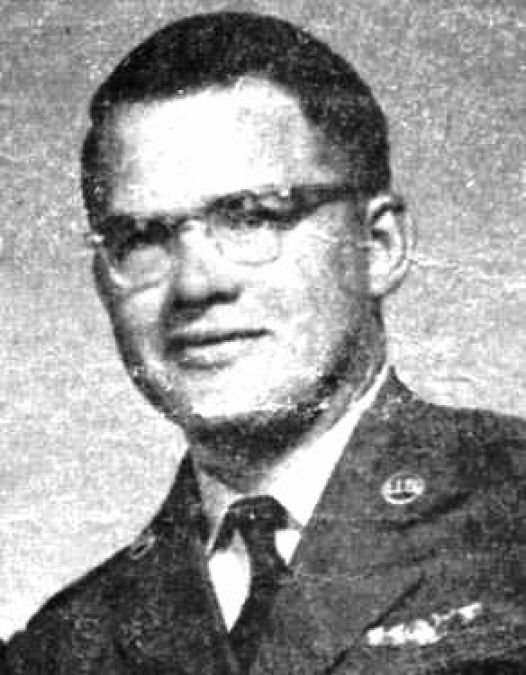


|
James J. Clouse Final Flight on December 06, 1970
|

James J. Clouse, TSgt., USAF (Fallen)
- December 06, 1970

Making the Family Proud...
Originally from Eddyville, Nebraska – James Clouse, a devout Catholic, was a husband and father to seven children. He enlisted in the Air Force in July of 1952. He had served in the Air Force nearly 18 years to that point, and served two tours in Southeast Asia – one in Vietnam, and the other in Thailand.
Responding to the scene of a fire near his air base in Thailand, in January of 1969, the pilot of a Special Operations CH-3E helicopter (tail number #63-09689, and call sign 'Dusty 689'), that Clouse was flight engineer aboard, suffered vertigo as it crashed in the jungle.
Clouse received the Airman’s Medal for, after exiting the burning helicopter, rushing back into the craft to rescue two other crewmembers, despite burns to himself, and the risk of the aircraft’s fuel exploding.
A month later, in late February of 1969, Clouse again displayed heroism when, near the South Vietnam DMZ, he penetrated intense hostile fire to rescue five crewmembers from certain death who had been shot down for enemy forces. For his actions, Clouse was awarded the Distinguished Flying Cross
James Clouse was buried at St. Patrick's Catholic Cemetery near Eddyville, Nebraska, in Lot #13 of the cemetery's western half.
Check-Six.com Last of the Giants… Near Palisade, Nebraska February 6th, 1970 Global Reach...
Powered by four Pratt & Whitney T34-P-9W turboprop engines, each producing 7,500 horsepower, the Douglas C-133B ‘Cargomaster’ could carry up to 110,000 pounds of cargo. The airframe, and its 179 feet wingspan, and 157 feet of length, was even massive enough to transport the Atlas, Titan and Minuteman families of ballistic missile, and could fly at a speed of over 300 knots for a range of up to 3,560 miles.
The C-133 was for many years the only aircraft capable of hauling very large or very heavy cargo. Despite the C-124 Globemaster's capabilities, there was much cargo that it could not carry because of its configuration with a cargo deck 13 feet off the ground and its lower, though substantial, engine power. The Air Force purchased fifty of the airborne behemoths as the backbone of their Military Air Transport Service.
A Transcontinental 'Milk Run'...
The mission that Thursday night was a sortie from Travis AFB, California, to Harrisburg, Pennsylvania, to transport several Lycoming T53 and T55 engines in sealed transport containers, and one Boeing CH-47B Chinook (possibly 67-8487), all bound for the US Army Depot in New Cumberland, Pennsylvania.
The flight crew, part of the 1501st Air Transport Wing at Travis AFB, consisted of: Pilot and aircraft commander Major Harold W. Tabor, 44, and a native of Grand Junction, Colorado. His co-pilot, 1st Lt. Duane D. Burdette, 24, was from Gahanna, Ohio. The flight loadmaster was Staff Sgt. Ira E. Bowers, 38, of Plymouth, New York, and the two flight engineers aboard were Master Sgt. Joseph P. Tierney, 34, Fairfield, California, and Tech Sergeant James J. Clouse of Vacaville, California.
"Like Fireworks Going Off"...
Aerial view of the crash site of #59-0530. Number 1 is the plane's left wing, #2 is the right wing, and #3 is the engines. (USAF Photo)
The Air Force investigation found that an existing 11" crack above the left side door, and hidden under the aircraft’s paint, suddenly expanded lengthwise, resulting in further tearing of the upper forward fuselage skin for a length of nearly 17 feet.
This rapid crack development in the fuselage set off an explosive decompression of the plane's cabin, as the plane was cruising aloft at 23,000 feet. This caused large sections of the aircraft aluminum skin, from both the top and right side of the fuselage, to be peeled back and away, blowing portions straight back, and into the right inboard engine - setting it ablaze.
The resulting stresses tore the plane apart, and rained ruin down on the Nebraska countryside.
Calling It Quits...
By 1971, a year after this final crash of a C-133B, and shortly before the introduction of the T-tailed Lockheed C-5 Galaxy, the Cargomasters still in service were deemed obsolete and worn out (their original airframe duty life of 10,000 having been extended three times, first to 15,000, then 17,000, and finally 19,000 hours of flight time) and were all slated for withdrawal from duty by the Air Force.
Over their service life, severe vibrations from the 18-foot in diameter propellers that the Cargomasters used had caused critical stress corrosion of the airframes to the point that the aircraft were beyond the point of economical operation. However, the Air Force managed to maintain and keep many of the aircraft in its fleet of C-133s in service until the C-5 finally entered squadron service in October of 1970.
Special Thanks: to Cal Taylor and his website for sharing images from the Official USAF Accident Investigation Report of the crash of Cargomaster #59-0530. Look for his book (Remembering An Unsung Giant - The Douglas C-133 Cargomaster and Its People) at Amazon.com
| |||||||
|